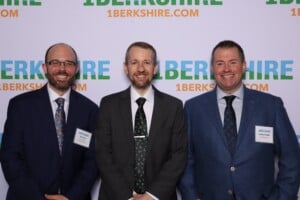The Berkshire Blueprint, Five Years In
Originally appeared in the May/June 2024 issue of Berkshire Magazine.
By Benjamin Lamb, Vice President of Economic Development, 1Berkshire

The 1Berkshire Economic Development Team: Ben Lamb, Kevin Pink, and Jonathan Butler.
In February 2019, after two years of research, engagement, and planning, 1Berkshire launched the Berkshire Blueprint 2.0. This ten-year strategic plan for regional economic growth presented a scaffolding that recognized where the region was, where we were headed, and what needed to happen to move us forward.
Over the first five years of the Blueprint’s life, the Berkshires has seen significant progress and growth, despite international economic volatility, increased impacts of climate change, and a pandemic. We have seen the emergence of our sixth primary economic cluster: outdoor recreation. We have experienced the expansion of entrepreneurial support and innovation resources like EforAll and the Berkshire Innovation Center. We have witnessed the pre-development, development, and redevelopment of housing like Windrush Commons in Great Barrington, commercial complexes like Pittsfield’s William Stanley Business Park Site 9, and long-planned projects like the Greylock Glen’s Outdoor Center. Investment continues at a meaningful clip, and we’ve seen powerful coalition building, resulting in things like the Housing Vision for the Berkshires, Berkshire Funding Focus, Berkshires Outside, and Berkshire Benchmarks’ relaunch. These collaborative endeavors continue to advance the work and provide strategic and tactical steps to further our future.
Persistent challenges require increased attention, investment, and strategic action to ensure that the Blueprint model remains meaningful.
The Berkshires continues to face transportation service gaps and mobility challenges within as well as to and from the region, as west-east rail options work through their respective processes. The workforce challenge in 2019 has become a full-blown crisis in 2024; we have more open positions than we do job seekers. Broadband (an absolute lifeline during the pandemic) still doesn’t reach everyone, with only one service provider and excessive costs for to-the-door access. Diversity, equity, and inclusion—slowly gaining traction across industries—continue to face an uphill battle in terms of improved practice adoption, meaningful investment, and appreciation as a regional priority. Any meaningful conversation in the Berkshires always comes back to housing. Gaps in affordable and market-rate housing production are exacerbating downward pressure on existing affordable housing, reducing access for the housing insecure. We are at a critical moment. Those are just some of the cross-cutting challenges that continue to demand focus and attention, and persist as priorities to be addressed moving ahead.
As 1Berkshire looks to benchmark this halfway point in the Blueprint’s anticipated life and to recommit to our collective approach going forward, it’s a moment to report on the impact of the past five years of work, the issues that we face looking ahead, and the powerful stories that represent a view into the region’s potential. We have a unique opportunity to share the stories of individuals, organizations, and efforts that are spearheading meaningful work. These stories will be told during the Blueprint 2.0 five-year event on May 30 from 9 to 11 a.m. at the Berkshire Innovation Center. We thought now might be a good time to give a sneak peak into one such effort.
Those who follow 1Berkshire’s work are likely familiar with the Blackshires Community Empowerment Foundation winning the 2023 “Breaking the Mold” Trendsetter Award last fall. That win was preceded by a tremendous amount of good (and hard) work. Founded in 2020 through Team R3SET, the Blackshires began as a platform for Black community connections in the Berkshires. Using TEAM R3SET’s experience in digital community building, their Idea Jam model for engagement and empowerment, and prowess in convening strategic partners around shared goals, they quickly fostered meaningful relationships, gathered an array of resources, and made an impact across the region.
The Blackshires mobilized around the critical need for more Black empowerment, leadership development, and representation. Their work helped organizations rethink their models to become more DEIB (Diversity, Equity, Inclusion, and Belonging) aware. They fostered leadership amongst the Black community, and connected Black community members with opportunities to take on high-impact roles in historically underrepresented spaces. The Blackshires has made large strides in its short years, resulting from its Idea Jam and strategic reports that helped accelerate their work in 2020; the launch of their award-winning Blackshires Leadership Accelerator, now in its second year; the building of the Equity Association to create an exchange for collaboration around DEIB principles and practices; and the emerging work around Black tourism as a huge opportunity for the Berkshires. John Lewis, founder and CEO of R3SET Enterprises, said, “This pioneering program not only equips BIPOC individuals with the skills needed for transformative leadership and civic engagement, but also paves the way for a future where decision-making bodies truly reflect the voices and experiences of all community members.”
The Blackshires Community Empowerment Foundation is a clear example of the types of high-impact Berkshire stories to be told in the context of the last five years. It’s about recognizing a gap in our region’s DEIB culture, building data-informed processes and strategies, furthering a purpose-driven collaborative culture, and owning the work in a high-impact way. Dubois Thomas, President of the Blackshires, noted, “We are excited to support the actualization of potential leaders as we grow our community’s ability to develop and implement business and programs whilst instilling the importance of healthy collaborative frameworks and community partnerships.”
We are on a new precipice, one that celebrates good work and collaboration, appreciates and acknowledges ongoing challenges, reinforces the need for all to play a role, and demands that each of us commits to taking on our respective objectives to get where we need to go. Let’s get to it.

